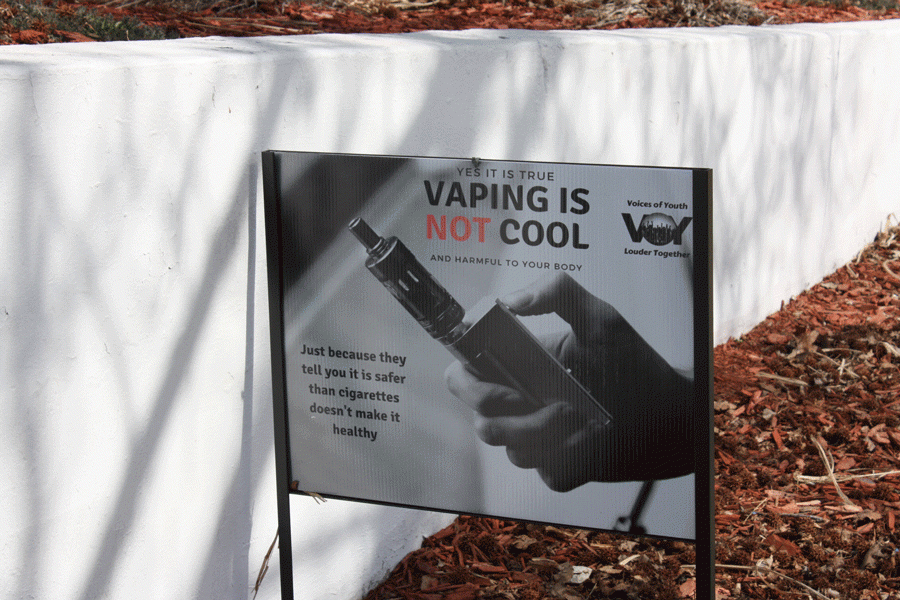Vaping becoming popular amongst Warsaw teens
An anti-vaping sign stands at the entrance of the high school. School administrators have noticed an increase in vaping at the school this year.
The vaping trend amongst teenagers has made itself apparent at WHS.
More and more students have been caught using e-cigarettes on campus, prompting discussion amongst teachers and administrators who are noticing the trend.
In a survey taken by The Wildcat staff through Google forms found that 46.6 percent of students surveyed have experimented with vaping. The anonymous survey was sent to all high school students through student email from March 14 to 20 with 103 students responding.
“I believe that vaping is harmful for our youth. It’s just as dangerous as tobacco, if not worse,” said assistant principal Cody Wright.
There are other consequences besides health risks, there are social and legal consequences too.
School administrators have noticed an increase in the possession and use of e-cigarettes at school. Out of the 103 students who answered the survey, 14 (13.6 percent) of them have admitted to vaping in school, or at a school function.
“The consequences of vaping at school, are three days in school suspension (ISS) if it’s found on you at school, or five days if it is consumed in the school,” said Wright.
It is also illegal in the state of Missouri for anyone under 18 to purchase or possess vape products, according to Public Health Law Center.
In her article ”Recreational Vaping 101; What is Vaping?”, on Center on Addiction, Linda Richter reported “vaping is the act of inhaling and exhaling the aerosol, often referred to as vapor, which is produced by an e-cigarette or similar device.” It is called vaping because instead of tobacco smoke being seen, it’s aerosol, which is sometimes mistaken for water vapor.
There are a few different types of e-cigarettes, one of the most well-known is a Juul. A Juul looks just like a flash drive, making them easy to hide or disguise.
Out of the 103 participants in the survey, 49.5 percent of the students said that they think vaping is a safer alternative to smoking, and that is not entirely true.
There are many health risks from vaping. According to research by Dr. Irina Petrache,PhD cited by the University Health News Daily website staff, “even the non-nicotine e-juices can be problematic.” The article, “Is Vaping Bad for You? A Look at Vaping versus Smoking,” reported that when researchers look closely at what’s in vape liquids, they’ve found a variety of additional substances, like Acrolein, Diethylene glycol, Nitrosamines, potentially toxic carbons, lead, heavy metal and silicates, and Propylene glycol.”
The University Health News article reported that many experts admit vaping might be “the lesser of two evils. Although formaldehyde levels are show to be higher, a study found that some toxic substances have levels 9 to 450 times lower than in regular cigarette smoke.” However, the long-term effects are unknown.
“I don’t think it is good for you. It is exactly like cigarettes, but basically you’re inhaling boiling liquid,” said freshman Lily Hovorka
In an Centers for Disease Control and Prevention (CDC) article titled “Quick Facts on the Risks of E-Cigarettes for Kids, Teens and Young Adults” reported e-cigarette aerosol that users exhale from the device, contains potentially harmful substances like Nicotine, Diacetyl a chemical linked to a serious lung disease, cancer causing chemicals, and metals like nickel tin and lead. Which is not only harmful to the person vaping, but to others. Just like with regular cigarettes, the second-hand smoke is almost worse than actually smoking because without the filter more gets into lungs.
Of the 103 surveyed, 24 students (23.3 percent) admitted that they either vaped or used Juuls, on a regular basis. Out of those 24 people, 22 believed that vaping is safer than actually smoking, which is a big reason why teenagers vape.
As stated in the article “The youth e-cigarette epidemic: 5 important things to know”
Truth Initiative.org, “Research shows that young people are more likely to try flavored e-cigarettes and believe that they are less harmful than tobacco-flavored e-cigarettes. Other reasons youth reported for using e-cigarettes include that they are easier to get than other tobacco products, cost less than other tobacco products and can be used in areas where other tobacco products, such as cigarettes, are not allowed. Some students reported that they used e-cigarettes to try to quit using other tobacco products, or because famous people on TV or in movies use them.”

Freshman Ashley Turner is looking forward to her first year as a member of the journalism department. Recommended by her English teacher, Turner chose...













